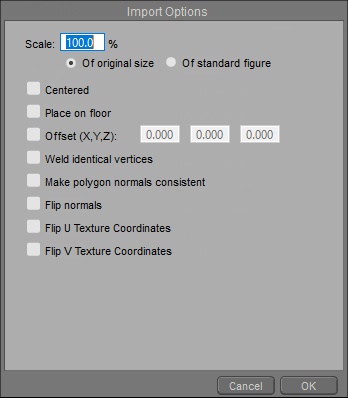Importing 3D File Formats
Most 3D modeling applications support at least one of the formats that is supported by Poser, which allows you to import geometries in the following formats:
- 3D Studio Max (File > Import > 3D Studio)
- DXF (File > Import > DXF)
- LightWave LWO files (File > Import > LightWave...)
- Wavefront OBJ (File > Import > Wavefront OBJ)
- COLLADA: See COLLADA Import .
- FBX: See Importing FBX Files .
- ZBrush: See Using Poser with ZBrush.
Some formats, such as Wavefront OBJ, allow you to save geometries as either polygons or NURBS surfaces. Poser will only accept geometries saved as polygons.
Poser will import smoothing groups in Wavefront OBJ format, as defined in the source file. If no smoothing groups are specified in the source file, none will be imported. Please refer to Smoothing Geometry for more information about smoothing groups.
Note that while Poser does not support the 3ds Max style of defining smoothing groups, Poser does take into account the vertex normals when determining creases. As a result, OBJ files exported from 3ds Max will usually appear as expected, despite the fact that the 3ds Max smoothing groups are not read.
When choosing 3DS, DXF, LightWave, or Wavefront OBJ format, the Import Options dialog appears, and presents the following options:

Import Options dialog.
- Scale: Allows you to choose whether to scale the model at percentage of original size, or of standard figure size.
- Of original size: Choose this option if you want to scale the model based on the actual size of the geometry that you are importing. The default is 100% of original size, which will import your model in exactly the same size that it was exported from your modeler. If your model was exported at a larger scale, enter a different value in the Scale field.
- Of standard figure: Choose this option to use the legacy method of figure import. Poser’s standard figure size is approximately six feet tall.
Poser’s model scaling is considerably smaller than “real world” scaling typically used in 3D modelers. Many content creators export from Poser at about 100 times Poser scale (10000%), and then import back into Poser at 1/100 scale (1%).

A figure imported at 100% figure size is six feet tall.
- Centered: Check this option to center the model at zero X, Y, and Z coordinates. This will cause half of the model to be beneath ground level unless you select Place on Floor below. If you want your model to be imported in exactly the same position at which it was modeled, uncheck this option.
- Place on Floor: Check this option to place the bottom-most portion of the imported object at ground level. Uncheck this option to import the object in its default modeled position.
- Offset (X,Y,Z): Check this option and enter specific X, Y, and Z coordinates if you want your model to be offset by a specific amount from the zero coordinates. Uncheck this option to import the object in its default modeled position.
- Weld Identical Vertices: Check this option to remove vertices that exist in exactly the same position.
- Make Polygon Normals Consistent: Check this option to ensure that polygon normals are imported facing in the same direction. Uncheck the option if you want to maintain normals as they are presently modeled.
- Flip Normals: Check this option to import a model with its normals facing in the opposite direction. Uncheck the option to import the model with normals facing in the direction in which they are modeled.
- Flip U Texture Coordinates: Check this option to flip the UV texture coordinates on the horizontal (U) axis.
- Flip V Texture Coordinates: Check this option to flip the UV texture coordinates on the vertical (V) axis.